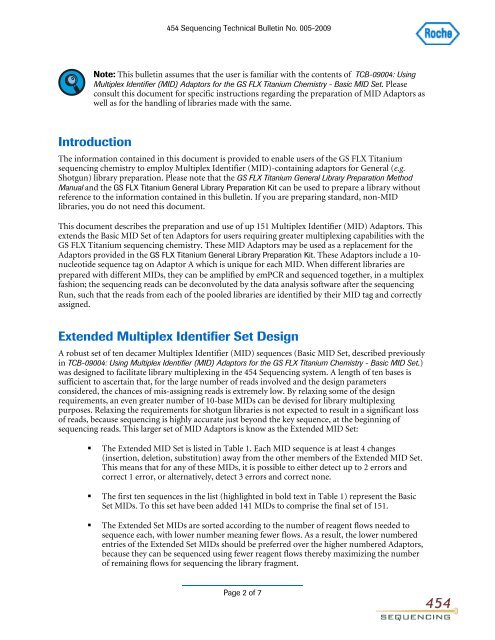Roche MID adapters
Roche MID adapters
Roche MID adapters
Create successful ePaper yourself
Turn your PDF publications into a flip-book with our unique Google optimized e-Paper software.
454 Sequencing Technical Bulletin No. 005-2009<br />
Note: This bulletin assumes that the user is familiar with the contents of TCB-09004: Using<br />
Multiplex Identifier (<strong>MID</strong>) Adaptors for the GS FLX Titanium Chemistry - Basic <strong>MID</strong> Set. Please<br />
consult this document for specific instructions regarding the preparation of <strong>MID</strong> Adaptors as<br />
well as for the handling of libraries made with the same.<br />
Introduction<br />
The information contained in this document is provided to enable users of the GS FLX Titanium<br />
sequencing chemistry to employ Multiplex Identifier (<strong>MID</strong>)-containing adaptors for General (e.g.<br />
Shotgun) library preparation. Please note that the GS FLX Titanium General Library Preparation Method<br />
Manual and the GS FLX Titanium General Library Preparation Kit can be used to prepare a library without<br />
reference to the information contained in this bulletin. If you are preparing standard, non-<strong>MID</strong><br />
libraries, you do not need this document.<br />
This document describes the preparation and use of up 151 Multiplex Identifier (<strong>MID</strong>) Adaptors. This<br />
extends the Basic <strong>MID</strong> Set of ten Adaptors for users requiring greater multiplexing capabilities with the<br />
GS FLX Titanium sequencing chemistry. These <strong>MID</strong> Adaptors may be used as a replacement for the<br />
Adaptors provided in the GS FLX Titanium General Library Preparation Kit. These Adaptors include a 10-<br />
nucleotide sequence tag on Adaptor A which is unique for each <strong>MID</strong>. When different libraries are<br />
prepared with different <strong>MID</strong>s, they can be amplified by emPCR and sequenced together, in a multiplex<br />
fashion; the sequencing reads can be deconvoluted by the data analysis software after the sequencing<br />
Run, such that the reads from each of the pooled libraries are identified by their <strong>MID</strong> tag and correctly<br />
assigned.<br />
Extended Multiplex Identifier Set Design<br />
A robust set of ten decamer Multiplex Identifier (<strong>MID</strong>) sequences (Basic <strong>MID</strong> Set, described previously<br />
in TCB-09004: Using Multiplex Identifier (<strong>MID</strong>) Adaptors for the GS FLX Titanium Chemistry - Basic <strong>MID</strong> Set.)<br />
was designed to facilitate library multiplexing in the 454 Sequencing system. A length of ten bases is<br />
sufficient to ascertain that, for the large number of reads involved and the design parameters<br />
considered, the chances of mis-assigning reads is extremely low. By relaxing some of the design<br />
requirements, an even greater number of 10-base <strong>MID</strong>s can be devised for library multiplexing<br />
purposes. Relaxing the requirements for shotgun libraries is not expected to result in a significant loss<br />
of reads, because sequencing is highly accurate just beyond the key sequence, at the beginning of<br />
sequencing reads. This larger set of <strong>MID</strong> Adaptors is know as the Extended <strong>MID</strong> Set:<br />
• The Extended <strong>MID</strong> Set is listed in Table 1. Each <strong>MID</strong> sequence is at least 4 changes<br />
(insertion, deletion, substitution) away from the other members of the Extended <strong>MID</strong> Set.<br />
This means that for any of these <strong>MID</strong>s, it is possible to either detect up to 2 errors and<br />
correct 1 error, or alternatively, detect 3 errors and correct none.<br />
• The first ten sequences in the list (highlighted in bold text in Table 1) represent the Basic<br />
Set <strong>MID</strong>s. To this set have been added 141 <strong>MID</strong>s to comprise the final set of 151.<br />
• The Extended Set <strong>MID</strong>s are sorted according to the number of reagent flows needed to<br />
sequence each, with lower number meaning fewer flows. As a result, the lower numbered<br />
entries of the Extended Set <strong>MID</strong>s should be preferred over the higher numbered Adaptors,<br />
because they can be sequenced using fewer reagent flows thereby maximizing the number<br />
of remaining flows for sequencing the library fragment.<br />
Page 2 of 7
















